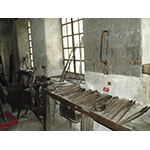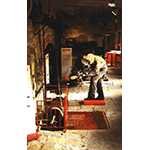Ferriera Sabatini [Sabatini Ironworks]
The Ironworks ordered by Cosimo I de’ Medici was built in Pracchia in 1542 as a furnace for the production of cast iron along the course of the Reno River. Along with the other ironworks in the Pistoian Mountains, until the end of the 18th century, it formed the most important ironworking centre of the Grand Duchy of Tuscany. Later purchased by the Sabatini family, it remained in activity until the mid 20th century. In 1992, part of the building was rehabilitated and later opened to the public under the management of the Pistoian Mountain Ecomuseum. Currently it is no longer part of the Ecomuseum circuit and it is closed to the public awaiting restructuring. The Ironworks exhibition presented several work tools and old machinery used for smelting and working iron from the 16th to the 20th century. The operations of forging and beating iron were also illustrated for educational purposes.
The presence of numerous ironworks in the Pistoian Mountains can be explained by the contemporaneous abundance of water, which served to drive the hammers and bellows, and of wood, which served as fuel (charcoal). To reach the mountains, the iron had to travel a long and laborious route. From the mines on Elba Island, the iron was transferred to the smelting furnaces of Maremma, which reduced the mineral into pig iron. From here, it was loaded onto boats that carried it to Livorno or to Bocca d’Arno. Aboard small boats, it climbed up the Arno River until Lastra a Signa. Then it was hauled on the Ombrone stream until Poggio a Caiano where, first in drays and then on pack animals, it finally reached the ironworks in the Pistoian Mountains, where it was reduced into large bars or rods called cionconi. These were then transported to other factories near the ironworks, called distendini, which reduced them into little bars of different thicknesses and shapes by means of a type of hammer (distendino), but smaller than the one used in the ironworks. The final process took place in the numerous craftsmen’s workshops or in the factories of nails, wire, shovels and rifle barrels.
****************************
Texts by Graziano Magrini
English translation by Victor Beard
Last update 30/gen/2008





